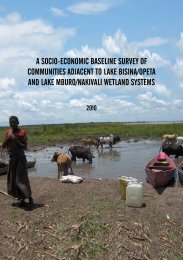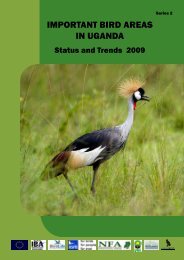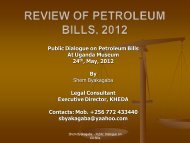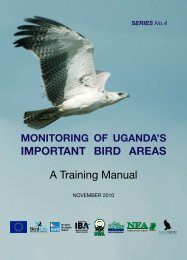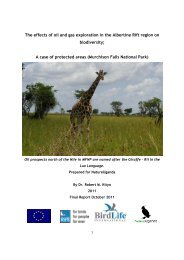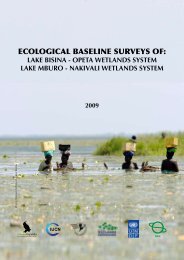the economic valuation of the proposed ... - Nature Uganda
the economic valuation of the proposed ... - Nature Uganda
the economic valuation of the proposed ... - Nature Uganda
Create successful ePaper yourself
Turn your PDF publications into a flip-book with our unique Google optimized e-Paper software.
The demand for sugar has also been growing in <strong>the</strong><br />
eastern Africa region. In order to achieve growth targets<br />
<strong>the</strong>refore, <strong>the</strong> sugar industry has been classified as<br />
a sensitive industry that requires effective safeguard<br />
measures (Serunkuma and Kimera, 2006). In Kenya, <strong>the</strong><br />
area under sugarcane was 151,014 hectares by <strong>the</strong> end<br />
<strong>of</strong> 2006 and <strong>the</strong> average yield was 71.46 mts/ha. The<br />
amount <strong>of</strong> cane crushed was 4,850,333 mts. The amount<br />
<strong>of</strong> sugar produced by Kenyan sugar factories was<br />
475,669 mts. In 2006, production fur<strong>the</strong>r declined to 475<br />
653 mts against a demand <strong>of</strong> 718,396 mts (Kenya Sugar<br />
Board in <strong>the</strong> East African Standard, 2007). In Tanzania,<br />
<strong>the</strong> annual sugar production was about 115,000 tonnes,<br />
while <strong>the</strong> demand <strong>of</strong> sugar is estimated at 300,000<br />
tonnes. As such, Tanzania imports about 200,000 tonnes<br />
per annum to <strong>of</strong>fset <strong>the</strong> shortfall (Tanzania Ministry <strong>of</strong><br />
Agriculture, Food and Cooperatives, 2007).<br />
3.2 HISTORY OF THE SUGAR INDUSTRY IN<br />
14<br />
UGANDA<br />
Sugarcane production in <strong>Uganda</strong> dates back to 1924<br />
when <strong>the</strong> first sugar factory was established in <strong>Uganda</strong><br />
and East Africa. The factory was <strong>the</strong>n known as <strong>Uganda</strong><br />
Sugar Factory Limited. The factory has since changed<br />
to <strong>the</strong> Sugar Corporation <strong>of</strong> <strong>Uganda</strong> Limited (SCOUL)<br />
(Serunkuma and Kimera, 2006). The Sugar Corporation<br />
<strong>of</strong> <strong>Uganda</strong> Limited was established by <strong>the</strong> late Najir<br />
Kalidas Mehta who came to <strong>Uganda</strong> from India in 1901.<br />
The second sugar factory opened at Kakira in 1930. It<br />
was started by <strong>the</strong> late Muljibhai Madhvani who also<br />
came to <strong>Uganda</strong> from India in 1908. Two o<strong>the</strong>r sugar<br />
establishments were made at Sango Bay in Rakai District<br />
and at Kinyara in Masindi District. Sugar production at<br />
Sango Bay started in 1972 but was shut down in 1973<br />
following <strong>the</strong> expulsion <strong>of</strong> <strong>the</strong> Asian owners during<br />
<strong>the</strong> Idi Amin government. The National Sugar Works in<br />
Kinyara near Masindi (Kinyara Sugar Works) was initiated<br />
in <strong>the</strong> 1960s and implemented in <strong>the</strong> early 1970s.<br />
<strong>Uganda</strong> has good physical attributes for <strong>the</strong> successful<br />
production <strong>of</strong> sugar. Peak production reached 152,000<br />
mts in 1968, and by 1969, <strong>Uganda</strong> was able to export<br />
about 48,000 mts <strong>of</strong> sugar. In <strong>the</strong> 1950s and 1960s, with<br />
just SCOUL and Kakira Sugar Works, <strong>Uganda</strong> was one <strong>of</strong><br />
<strong>the</strong> world leaders in <strong>the</strong> sugar industry with production<br />
at a tune <strong>of</strong> 140,000 mts <strong>of</strong> sugar per year. For example,<br />
about 20,000 mts <strong>of</strong> sugar/year were exported to <strong>the</strong><br />
United States <strong>of</strong> America and regionally to neighbouring<br />
countries. <strong>Uganda</strong>’s premier position in <strong>the</strong> sugar sector<br />
declined following <strong>the</strong> <strong>economic</strong> and political upheavals<br />
<strong>of</strong> <strong>the</strong> Amin and Obote II regimes. Sugar production<br />
actually plummeted to almost zero by 1983. Sugar<br />
estates were abandoned, machinery fell into disrepair,or<br />
were looted, and <strong>the</strong> physical and social infrastructure<br />
deteriorated (AfDB, 2002). The country became entirely<br />
dependent on imported sugar. The sector has however<br />
partly recovered following <strong>the</strong> return <strong>of</strong> Asians in <strong>the</strong><br />
mid 1980s. In 1988, <strong>the</strong> Mehta Group repossessed and<br />
commissioned <strong>the</strong> rehabilitation <strong>of</strong> <strong>the</strong> SCOUL factory<br />
in Lugazi. Between 1985 and 1995 Kakira Sugar Works<br />
1985 Ltd underwent rehabilitation and Kinyara Sugar<br />
Works was rehabilitated between 1986 and 1996 1 .<br />
The Economic Recovery Program initiated in 1987 and<br />
<strong>the</strong> Structural Adjustment Programme <strong>of</strong> <strong>the</strong> early<br />
1990s promoted <strong>the</strong> rehabilitation <strong>of</strong> <strong>the</strong> agricultural<br />
sector, including <strong>the</strong> sugar industry. The rehabilitation<br />
in <strong>the</strong> sugar industry looked at <strong>the</strong> rehabilitation <strong>of</strong><br />
sugarcane yields <strong>of</strong> <strong>the</strong> nucleus plantation; e<strong>valuation</strong> <strong>of</strong><br />
current systems and methods <strong>of</strong> sugarcane production<br />
and set up methods and means to achieve production<br />
<strong>of</strong> sugarcane at minimum costs. It also examed advice<br />
on options for <strong>the</strong> diversification <strong>of</strong> <strong>the</strong> industry and <strong>the</strong><br />
institutional and legislative requirements to improve<br />
management <strong>of</strong> <strong>the</strong> industry.<br />
The sugar industry employs about 21,749 persons<br />
on a permanent, contract and casual labour basis. Of<br />
<strong>the</strong>se eighty to ninety (80–90) percent are members<br />
<strong>of</strong> <strong>the</strong> National Union <strong>of</strong> Plantation Workers <strong>of</strong> <strong>Uganda</strong><br />
(NUPAWU) (<strong>Uganda</strong> Land Coalition, 2006). In addition,<br />
<strong>the</strong> sugar industry engages approximately 40,000<br />
1 Between 1985 and 1988, <strong>the</strong>re was no sugar production<br />
as all factories were under rehabilitation<br />
The Economic Valuation <strong>of</strong> <strong>the</strong> Proposed Degazettement <strong>of</strong> Mabira CFR | 2011



